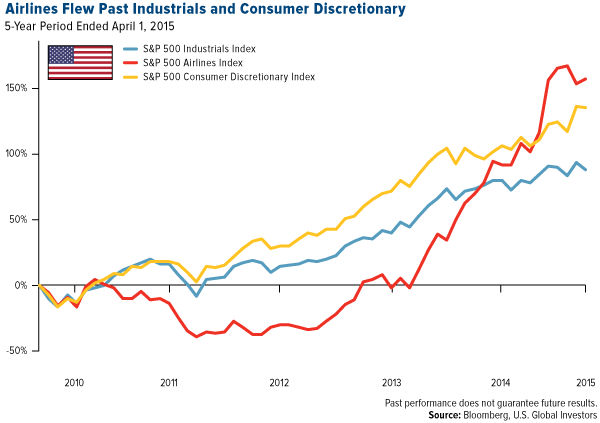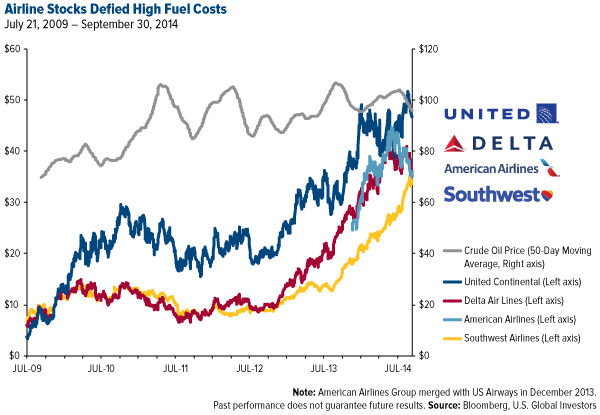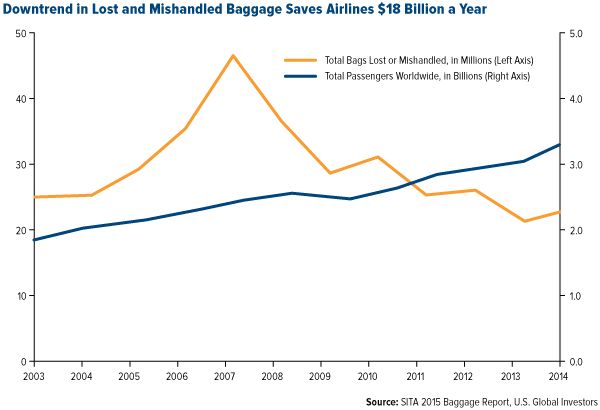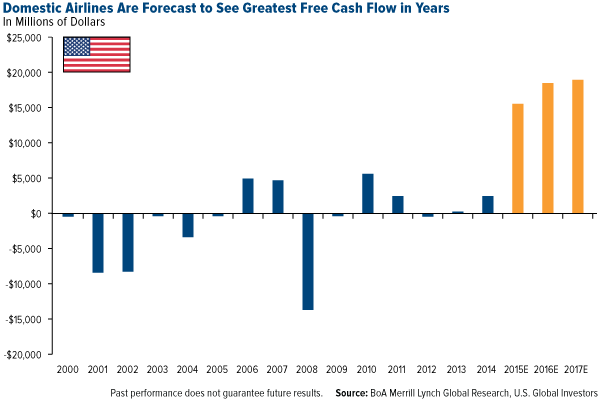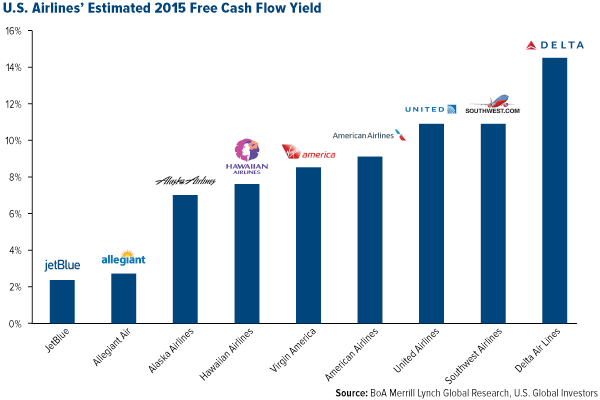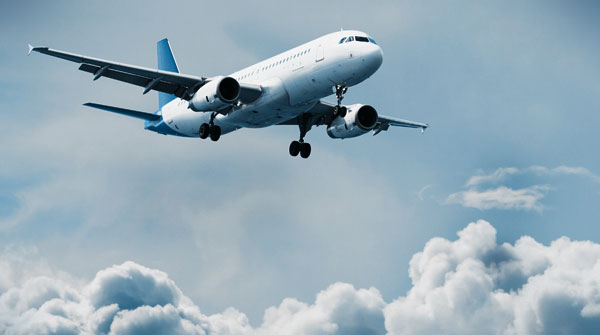
The week before last I was in Melbourne, Australia, attending a conference for chief executives from all over the world. While there, I spoke with many of my peers about the airline industry, which is currently in a three-year bull run as measured by the S&P 500 Airlines Index.
I was surprised to learn that several people incorrectly assumed that the airline industry is included in the consumer discretionary sector of the S&P 500 Index. It does seems as if it belongs there, along with travel, hospitality and leisure. But the industry actually qualifies as an industrial.
Regardless of which sector airlines belong in, the fleet has flown past both industrials and consumer discretionaries for the five-year period.
Not only that, but airlines were the best-performing industry in industrials for the one-year, three-year and five-year periods.
| Percent Change | ||
|---|---|---|
| 1-Year | 3-Year | 5-Year |
| Airlines +45% | Airlines +288% | Airlines +142% |
| Professional Services +21% | Building Products +109% | Road & Rail +134% |
| Commercial Services & Suppliers +19% | Aerospace & Defense +75% | Aerospace & Defense 93% |
A misconception held among some investors is that airline stocks are outperforming right now only because fuel costs are down. Fuel, after all, accounted for about 30 percent of carriers’ operating costs in 2014. The implication, some believe, is that when oil prices begin to recover, airlines will be first to feel the pinch.
This isn’t necessarily the case. The industry is in a much more rational business environment than it was a decade ago. Over the last five years, fundamental changes have taken place, including consolidation, new sources of revenue, better fuel efficiency and additional seats, that have helped airlines excel even when oil is $100 per barrel or more.
In fact, airline stocks for the four industry leaders—United Airlines, Delta Air Lines, American Airlines and Southwest Airlines—began their recent ascent even before oil prices began to plummet 50 to 60 percent starting last summer.
And because most airlines hedge their fuel, they’re still locked into $100-per-barrel oil prices and therefore haven’t yet felt the full benefits of lower fuel costs. American is one of the few that doesn’t hedge.
Airline research analyst Helane Becker of financial services firm Cowen Group writes:
American participates in 100 percent of the decline in jet fuel prices. The current per gallon price is $1.78, and American uses 4.4 billion gallons of jet fuel annually, so every $1 change in oil [saves the company] approximately $105 million per month.
Contributing to American’s diminishing operating costs is its purchase of dozens of new aircraft—99 delivered last year, 112 expected this year—that will replace older, less-fuel efficient jets. This should help the company save millions not only in jet fuel but also maintenance fees for many years to come.
It should also be noted that new baggage-tracking technology has led to a dramatic decrease in lost and mishandled luggage, helping airlines all over the globe save billions and keep passengers happy. Even as the number of worldwide passengers has steadily increased year-over-year—exceeding a record three billion in 2013—there’s been a drop of 61 percent in missing bags since the peak in 2007. As a result, carriers save a collective $18 billion a year.
Free Cash Flow
Often it’s not enough to look just at a company’s revenue for any given timeframe to determine its strength. A more precise metric is free cash flow, which tells you how much cash the company has in the bank after taxes and all operating expenses have been paid. In other words, it’s what the company is “free” to spend.
The higher a company’s free cash flow yield, the better. When the yield is higher, the company is more likely to plow that extra cash back into its growth or declare a dividend. American, for instance, began paying a dividend last summer; Alaska Airlines, the summer before last.
Last year, Delta announced a stock buyback plan worth $2 billion and a dividend increase of 50 percent. At this May’s Bank of America Merrill Lynch Industrials Conference, the company is expected to make a similar announcement—another buyback authorization and a possible dividend boost of 25 percent.
As you can see below, U.S. airlines’ free cash flow is expected to reach a record high this year and each subsequent year. Domestic carriers have never had this much cash potential on their hands—cash that can be used to grow and improve their businesses as well as reward shareholders.
If we look at individual companies’ free cash flow, three of them—Delta, Southwest and United Airlines—are expected to have yields above an impressive 10 percent in 2015.
An airline industry report by J.P. Morgan stated last week:
We believe in the persistence of cash flows and the presence of a good structural model. The sector has begun to show us their success instead of repeating “trust me”… [T]he cash is real, the margins are real, the buybacks are real.
In light of this success, some analysts are concerned that airlines, flush with cash for the first time in recent memory, will increase capacity too quickly and outpace demand.
Two main arguments can be made here. For one, the industry is highly correlated to a nation’s GDP, and carriers have historically avoided growing faster than the economy by too wide of a margin. The second argument has to do with what experts believe is an imminent pilot shortage in the U.S.
Pilot Shortage Ahead?
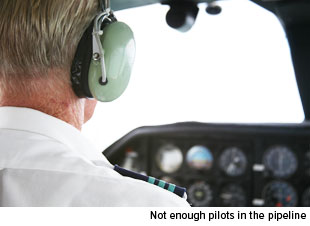 |
The Federal Aviation Administration (FAA) mandates that all pilots must retire at age 65, which should open up many commercial airliner positions over the coming years. But because the starting salary with a regional carrier is around $20,000 per year, fewer and fewer would-be aviators can justify the typical $50,000-a-year flight training, not to mention the required 1,500 hours of flight time before they can even be considered for a position.
You might be wondering why carriers aren’t able to make up the difference by recruiting more pilots out of the military. The reason is because a greater number of people are being trained now to fly drones than jets—and piloting a drone doesn’t count toward commercial flight hours.
This all might sound like troubling news, but it actually has the effect of encouraging discipline, reining in excessive spending and curbing carriers from growing too exuberantly. They can always increase seat capacity—to a certain extent, of course—but generally they’re not going to spend money needlessly on new aircraft if there are fewer people available to pilot them.
Read more about the airline industry:
- Global Airline Stocks Soaring, and Not Just Because of Low Oil Prices
Although it’s true that fuel is carriers’ top operating expense—they collectively spent $48 billion on fuel in 2013—there’s more to the industry’s recent bull run than the low price of oil. In fact, airlines are in a better position now to manage an increase in oil prices than they have been in recent memory, for a number of reasons.
- The Airline Industry Ascended to New Records in 2014
This year, the daily number of available seats for international-bound flights out of the U.S. will rise to an all-time high of over 350,000. That’s 20,000 more seats per day than were available just last year.
- Why This Airline Just landed in the S&P 500 Index
Joining rivals Southwest Airlines and Delta Air Lines, American Airlines is the newest member of the prestigious club for the nation’s largest companies by market capitalization. Not bad for a company that, only four years ago, found itself in bankruptcy court.
The S&P 500 Stock Index is a widely recognized capitalization-weighted index of 500 common stock prices in U.S. companies. The S&P 500 Industrials Index comprises those companies included in the S&P 500 that are classified as members of the GICS industrials sector. The S&P 500® Consumer Discretionary Index comprises those companies included in the S&P 500 that are classified as members of the GICS® consumer discretionary sector. The S&P 500 Airlines Index is a capitalization-weighted index.
Fund portfolios are actively managed, and holdings may change daily. Holdings are reported as of the most recent quarter-end. The following securities mentioned in the article were held by one or more of U.S. Global Investors Funds as of 12/31/2014: Delta Air Lines, Inc.; Alaska Air Group.
There is no guarantee that the issuers of any securities will declare dividends in the future or that, if declared, will remain at current levels or increase over time.
All opinions expressed and data provided are subject to change without notice. Some of these opinions may not be appropriate to every investor. This news release may include certain “forward-looking statements” including statements relating to revenues, expenses, and expectations regarding market conditions. These statements involve certain risks and uncertainties. There can be no assurance that such statements will prove accurate and actual results and future events could differ materially from those anticipated in such statements.






